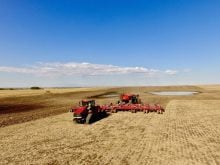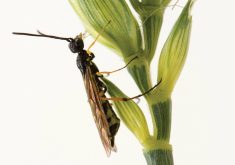Favourable weather for most of the province allowed producers to continue to make good progress in the field, according to Saskatchewan Agriculture’s weekly Crop Report. Fifty-eight per cent of the crop is now in the bin, well ahead of the five-year (2013-2017) average of 37 per cent for this time of year. Twenty-eight per cent of the crop is now swathed or ready to straight-cut. Rain showers toward the end of the week slowed down field progress, particularly in the eastern and northern regions, where the majority of the rain was recorded.
Read Also

Claas brings 1000 Series SP forage harvesters to Canada
In mid-August, Claas unveiled its new line of Jaguar forage harvesters at an event in Visalia, California, deep in the heart of that state’s dairy region.
Harvest is most advanced in the southwest region, where 82 per cent of the crop is now combined. The southeast region has 77 per cent combined, the west-central 53 per cent and the east-central region has 49 per cent combined. The northeast region has 27 per cent combined while the northwest region has 16 per cent combined.
Ninety-six per cent of the lentils, 94 per cent of the field peas, 73 per cent of the durum, 46 per cent of spring wheat, 38 per cent of the canola, and 14 per cent of the flax and soybeans have now been combined.
Sixty per cent of the durum is estimated to grade 1CW, while 34 and six per cent is estimated to grade 2CW and 3CW, respectively. Fifty per cent of the pea crop is estimated to fall in the 1 CAN grade, while 46 and four per cent are estimated to grade 2 CAN and 3 CAN, respectively. Forty-six per cent of the lentils are estimated to grade 1 CAN, while 49 and five per cent is predicted to fall in the 2CAN and 3CAN category, respectively.
Across the province, topsoil moisture conditions on cropland are rated as 25 per cent adequate, 40 per cent short and 35 per cent very short. Hay land and pasture topsoil moisture is rated as 20 per cent adequate, 32 per cent short and 48 per cent very short.
Most areas of the province reported frost. Crop damage varies depending on maturity of the crop and degree of freezing temperatures.
Producers are busy swathing and combining crops.














